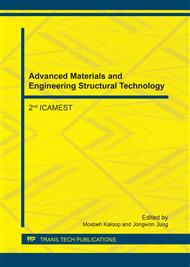[1]
M. Płońska, Z. Surowiak, Piezoelectric Properties Of X / 65 / 35 PLZT Ceramics Depended Of The Lanthanum ( X ) Ions Contents, J. Phys. IV, 27 (2006) 207-211.
DOI: 10.1051/jp4:2006137028
Google Scholar
[2]
T. Chen, H. Wang, T. Zhang, G. Wang, J. Zhou, J. Zhang, Y. Liu, Piezoelectric behavior of (1−x)K0. 50Na0. 50NbO3−xBa0. 80Ca0. 20ZrO3 lead-free ceramics, Ceram. Int., 39(6) (2013) 6619-6622.
DOI: 10.1016/j.ceramint.2013.01.098
Google Scholar
[3]
M. Koochaksaraee, Comparison Of Optical Properties Of PLZT ( 96 / 4 / 65 / 35 ) And PZT ( 65 / 35 ) Ceramics In Rhombohedral Phase, Int. J. Eng. Res. Appl. 3(1) (2013) 399-402.
Google Scholar
[4]
J. A. Gallagher, H. R. Jo, C. S. Lynch, Large-field dielectric loss in relaxor ferroelectric PLZT, 035007.
DOI: 10.1088/0964-1726/23/3/035007
Google Scholar
[5]
Q. Zheng, T. Yang, K. Wei, J. Wang, X. Yao, Effect of Sn : Ti variations on electric filed induced AFE – FE phase transition in PLZST antiferroelectric ceramics, Ceram. Int., 38 (2012) S9-S12.
DOI: 10.1016/j.ceramint.2011.04.037
Google Scholar
[6]
P. William, Materials Theory Group Epitaxial strain tunes polarization and band gap in SnTiO3 Argonne National Laboratory, (2012) 4325.
Google Scholar
[7]
R. Cohen, First Principles Theories of Piezoelectric Materials I . The Origin of Piezoelectricity and Ferroelectricity : What we have learned from first-principles studies (1954) 1-22.
Google Scholar
[8]
T. Kühnlein, A. Stiegelschmitt, A. Roosen, M. Rauscher, Development of a model for the sintering of PZT multilayer ceramics and their dielectric properties, J. Eur. Ceram. Soc., 33(5) (2013) 991-1000.
DOI: 10.1016/j.jeurceramsoc.2012.10.018
Google Scholar
[9]
S. J. Clark, M. D. Segall, C. J. Pickard, P. J. Hasnip, M. I. J. Probert, K. Refson, M. C. Payne, First principles methods using CASTEP, Zeitschrift für Kristallographie, 220(5/6) (2005) 567-570.
DOI: 10.1524/zkri.220.5.567.65075
Google Scholar
[10]
A. Janotti, C. G. Van de Walle, LDA + U and Hybrid Functional Calculations for Defects in ZnO, SnO2, and TiO2, Adv. Calc, Defects Mater. Electron. Struct. Methods, 804 (2011) 155-164.
DOI: 10.1002/9783527638529.ch9
Google Scholar
[11]
M. F. M. Taib, M. K. Yaakob, O. H. Hassan, M. Z. A. Yahya, Structural, Electronic, and Lattice Dynamics of PbTiO 3 , SnTiO 3 , and SnZrO 3 : A Comparative First-Principles Study, Integr. Ferroelectr., 142(1) (2013) 119-127.
DOI: 10.1080/10584587.2013.780528
Google Scholar
[12]
M. K. Yaakob, M. F. M. Taib, M. S. M. Deni, M. Z. A. Yahya, Ab Initio Studies on the Structural and Electronic Properties of Bismuth Ferrite Based on Ferroelectric Hexagonal Phase and Paraelectric Orthorhombic Phase, Integr. Ferroelectr., 155 (2014).
DOI: 10.1080/10584587.2014.905306
Google Scholar
[13]
A. Bouhemadou, R. Khenata, M. Chegaar, S. Maabed, First-principles calculations of structural, elastic, electronic and optical properties of the antiperovskite AsNMg3, Phys. Lett. A, 371(4) (2007) 337-343.
DOI: 10.1016/j.physleta.2007.06.030
Google Scholar
[14]
A. K. Kalyani, L. K. V, A. R. James, A. Fitch, R. Ranjan, Unraveling the nature of electric field- and stress- induced structural transformations in soft PZT by a new powder poling technique, J. Phys. Condens. Matter, 27(7) (2015) 072201.
DOI: 10.1088/0953-8984/27/7/072201
Google Scholar
[15]
J. Baedi, M. R. Benam, M. Majidiyan, First-principles study of the effect of La substitution on the electronic and optical properties of Pb(Zr x Ti 1− x )O 3 crystal, Phys. Scr. 81 (2010) 035701.
DOI: 10.1088/0031-8949/81/03/035701
Google Scholar
[16]
V. Batra, S. Kotru, M. Varagas, and C. V. Ramana, Optical constants and band gap determination of Pb0. 95La0. 05Zr0. 54Ti0. 46O3 thin films using spectroscopic ellipsometry and UV-visible spectroscopy, Opt. Mater. (Amst). 49 (2015) 123–128.
DOI: 10.1016/j.optmat.2015.08.019
Google Scholar


